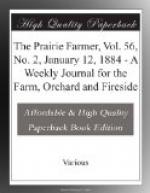THE CONTENTS OF THIS NUMBER.
Agriculture—Dew and Soil Moisture,
Page 17; Specialty in Farming, 17;
Public Squares in Small Cities, 17-18; Farm Names,
18; Diogenes In His
Tub, 18; Field and Furrow, 18-19; Agricultural Organizations,
19; Didn’t
No. 38 Die Hard, 19; A Grange Temple, 19.
Live stock—Items, Page 20; Swine Statistics, 20; Iowa Stock Breeders, 20; The Horse and His Treatment, 20; Items, 20-21.
The dairy—Winter Feed for Cows, Page 21; Churning Temperature, 21; Seas of Milk, 21.
Veterinary—About Soundness, Page 21; Questions Answered, 21.
Horticulture—The Hedge Question, Page 22; Young Men Wanted, 22; Possibilities of Iowa Cherry Growing, 22-23; Prunings, 23.
Floriculture—Gleanings by an Old Florist, Page 23.
Editorial—Items, Page 24; Illinois
State Board, 24-25; Sorghum at Washington, 25; The
Cold Spell, 25; American Ash, 25; Wayside Notes, 25;
Letter from Champaign, 25.
Poultry notes—A Duck Farm, Page 26.
The apiary—Apiary Appliances, Page 26; What Should be Worked For, 26.
Scientific—The Star of Bethlehem, Page 27.
Household—How the Robin Came, Poem,
Page 28; After Twenty Years, 28;
Will Readers Try It, 28; The Secret of Longevity,
28; How the Inventor
Plagues His Wife, 28; Recipes, 28; Pamphlets, etc.,
Received, 28.
Young folks—The City Cat, Poem,
Page 29; Amusing Tricks, 29; Bright
Sayings, 29; Compiled Correspondence, 29.
Literature—The Wrong Pew, Poem, Page 30; Yik Kee, 30-31.
Humorous—“A Leedle Mistakes,”
Page 31; Sharper Than a Razor, 31; A
Coming Dividend, 31.
News of the week—Page 31.
Markets—Page 32.
DEW AND SOIL MOISTURE.
Bulletin No. 6 of Missouri Agricultural College Farm is devoted to an account of experiments intended to demonstrate the relation of dew to soil moisture. Prof. Sanborn has prosecuted his work with that patience and faithfulness characteristic of him, and the result is of a most interesting and useful nature.
The Professor begins by saying that many works on physics, directly or by implication, assert that the soil, by a well-known physical law, gains moisture from the air by night. One author says “Cultivated soils, on the contrary (being loose and porous), very freely radiate by night the heat which they absorb by day; in consequence of which they are much cooled down and plentifully condense the vapor of air into dew.” Not all scientific works, however, make this incautious application of the fact that dew results from the condensation of moisture of the air in contact with cooler bodies. Farmers have quite universally accepted the view quoted, and believe that soils gain moisture by night from the air. This gain is considered of very great importance in periods of droughts, and is used in arguments favoring certain methods of tillage.




